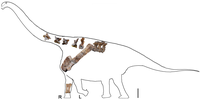The Hekou Group is a geological group in Gansu Province, China . It is Early Cretaceous in age. Many dinosaur fossils have been recovered from the Hekou Group, including iguanodonts , large sauropods , and armored dinosaurs . Fossil eggs are rare, but one oogenus, Polyclonoolithus [ 2] fossil tracks belonging to pterosaurs and dinosaurs have also been described.[ 3] [ 4] Valanginian to Albian and can be subdivided into four formations.[ 1]
Vertebrate paleofauna
Dinosaurs
Saurischians
Genus
Species
Region
Material
Notes
Images
Daxiatitan D. binglingi
Upper; Lanzhou-Minhe Basin[ 5]
A partial skeleton including cervical, dorsal, and caudal vertebrae, ribs, and a haemal arch , scapulocoracoid, and femur
A large titanosauriform sauropod
Huanghetitan H. liujiaxiaensis
Upper; Lanzhou-Minhe Basin[ 5]
A partial skeleton including caudal vertebrae, a partial sacrum and ribs, and the left shoulder girdle
A large titanosauriform sauropod
Yongjinglong [ 5] Y. datangi
Upper; Lanzhou-Minhe Basin
A partial skeleton including teeth, cervical and dorsal vertebrae, a rib, the left scapulocoracoid, and the right ulna and radius
A euhelopodid titanosauriform sauropod[ 6]
Ornithischians
Genus
Species
Region
Material
Notes
Images
Lanzhousaurus [ 7] L. magnidens
A partial skeleton including the mandible, maxillary teeth, dentary teeth, cervical and dorsal vertebrae, sternal plates, ribs, and pubes
A large styracosternan iguanodontian
Stegosaurus [ 8] S. sp.
Upper member; Lanzhou-Minhe Basin
A partial skeleton including cervical and dorsal vertebrae, ribs, a right forelimb (including a partial humerus, ulna, and radius), and one dermal plate
A stegosaur distinct from Wuerhosaurus and Stegosaurus stenops . Likely contemporary with Taohelong .
Taohelong [ 9] T. jinchengensis
Upper member; Lanzhou-Minhe Basin
A partial skeleton including ribs, a left ilium, a caudal vertebra, and part of the sacral shield
A nodosaurid ankylosaur, originally described as the first Asian member of the Polacanthinae
Fish
References
^ a b Xi, D.; Wan, X.; Li, G.; Li, G. (2018). "Cretaceous integrative stratigraphy and timescale of China". Science China Earth Sciences . 61 : 1– 31. doi :10.1007/s11430-017-9262-y . ^ Xie, J.-F., Zhang, S.-K., Jin, X.-S., Li, D.-Q., and Zhou, L.-Q. (2016) "A new type of dinosaur eggs from Early Cretaceous of Gansu Province, China. Archived 2016-01-29 at the Wayback Machine " Vertebrata PalAsiatica , 54(1):1-10.
^ Lockley, M.; Harris, J.D.; and Mitchell, L. 2008. "A global overview of pterosaur ichnology: tracksite distribution in space and time." Zitteliana . B28. p. 187-198. ISSN 1612-4138 .
^ Li, Dawing; Azuma, Yoichi; Fujita, Masato; Lee, Yuong-Nam; Arakawa, Yohei (2006). "A preliminary report on two new vertebrae track sites including dinosaurs from the Early Cretaceous Hekou Group, Gansu Province, china" . Journal of the Paleontological Society of Korea . 22 (1): 29– 49. ^ a b c Li, L. G.; Li, D. Q.; You, H. L.; Dodson, P. (2014). Butler, Richard J (ed.). "A New Titanosaurian Sauropod from the Hekou Group (Lower Cretaceous) of the Lanzhou-Minhe Basin, Gansu Province, China" . PLOS ONE . 9 (1): e85979. Bibcode :2014PLoSO...985979L . doi :10.1371/journal.pone.0085979 PMC 3906019 PMID 24489684 . ^ Mannion, P.D.; Upchurch, P.; Jin, X.; Zheng, W. (2019). "New information on the Cretaceous sauropod dinosaurs of Zhejiang Province, China: impact on Laurasian titanosauriform phylogeny and biogeography" . Royal Society Open Science . 6 (8): 191057. Bibcode :2019RSOS....691057M . doi :10.1098/rsos.191057 PMC 6731702 PMID 31598266 . ^ You, Hailu; Ji, Qiang; Li, Daqing (2005). "Lanzhousaurus magnidens gen. et sp. nov. from Gansu Province, China: the largest-toothed herbivorous dinosaur in the world" [中国甘肃发现世界上最大牙齿的植食性恐龙:巨齿兰州龙(新属、新种)]. Geological Bulletin of China . 24 (9): 785– 794. ISSN 1671-2552 . ^ Li, Ning; Li, Daqing; Peng, Guangzhao; You, Hailu (2024). "The first stegosaurian dinosaur from Gansu Province, China" . Cretaceous Research 158 (in press). 105852. Bibcode :2024CrRes.15805852L . doi :10.1016/j.cretres.2024.105852 . ^ Yang J.-T.; You H.-L.; Li D.-Q.; Kong D.-L. (2013). "First discovery of polacanthine ankylosaur dinosaur in Asia" (PDF) . Vertebrata PalAsiatica (in Chinese and English). 51 (4): 265– 277. ^ Peng, Cuo; Murray, Alison M.; Brinkman, Donald B.; Zhang, Jiang-Yong; You, Hai-Lu (2015-03-04). "A new species of Sinamia (Amiiformes, Sinamiidae) from the Early Cretaceous of Lanzhou Basin, Gansu, China". Journal of Vertebrate Paleontology 35 (2): e902847. Bibcode :2015JVPal..35E2847P . doi :10.1080/02724634.2014.902847 . ISSN 0272-4634 .
See also





